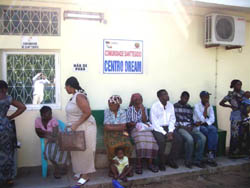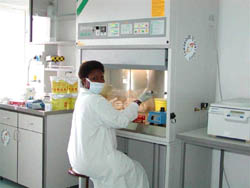THE DREAM PROGRAMME

A response to AIDS exists: treatment. But it’s not enough just to deliver antiretroviral drugs to African countries. Large-scale intervention is called for to bring about an overhaul of health systems in dismal conditions, and to re-launch and implement basic health education and promotion activities necessary to contain the spread of the epidemic.
The reality is that the presence of AIDS in Africa is linked to other problems: poverty, malnutrition, tuberculosis, malaria, and poor levels of health education, to cite a few examples. Focusing on HIV infection to the exclusion of this context is impossible. The need to assume wider responsibility emerges, not only from the point of view of tackling AIDS the disease, but also from the point of view of taking on a whole world of health services, the African world of health services. The struggle against AIDS, therefore, could well become the benchmark of a more responsible, more human globalisation, of a commitment to counter the growing international indifference about Africa.
Precisely in those years when the tendency to abandon Africa to its own devices was growing, the Community of Sant’Egidio felt the need for interdependence between the north and south of the world more strongly than ever, an awareness that the future should be shared or the world would become a very sad place. This consciousness emerged from being a Christian community that did not want to, or could not, remain indifferent to the demands of the world’s poorer regions and posed a challenge.
It is to this challenge that the Community of Sant’Egidio has sought to respond by setting up and promoting the DREAM – Drug Resource Enhancement against AIDS and Malnutrition – programme.

DREAM is nothing less than a dream come true: the dream of a different approach to AIDS (an approach combining prevention and treatment), the dream of a new approach to the entire world of African health services (an approach that has broken free from the chains of pessimism and resignation).
But realising DREAM has not been easy.

The biggest obstacle has been of a conceptual nature. Many things were simply not considered possible. Or rather, they were not considered possible in Africa, or not considered possible with Africans. It could be called “afro-pessimism,” an imaginary anthropological trend that has no concrete facts to support it, but nonetheless seems so real and unacceptable, presupposing an insurmountable difference between the European and the African, between “us” and “them.” It was said more or less openly, more or less in good faith, that Africans had no sense of time so they were unable to follow treatment properly. It was said that poor men and women like those living in sub-Saharan Africa would be tempted to resell what they had received – food, water filters, drugs and so on – rather than use such items to get better. It was said that unshakable legacies and cultural prejudice would impede mothers from deciding not to breastfeed their newborn babies.
In reality, at times, the cultural prejudice is ours. African mothers look after their children just as their western “counterparts” do, and they certainly do not deprive them of formula milk, nor do they neglect hygiene norms in its preparation, in line with instructions they have been given. Patients who feel their strength and health returning would never dream of reselling what has practically worked a miracle for them. Afro-pessimism, the ominous and fatalistic belief of many westerners that nothing can be done for Africa, that nothing ever works out well, that there are never the conditions to implement anything, really and truly have no raison d’être.
If anything, it is Africans’ pessimism that can be understood. Their life is hard, difficult in all senses. Let’s take, for example, the experience of doctors and paramedics: the lack of infrastructure and means, for health workers as well as for service users, the shortage of money even for the most basic needs… everything prompts them to be pessimistic.
But this is precisely where one can intervene. In the context of a partnership that ensures means and resources – drugs, wages, lab coats – within a serious professional framework, it becomes possible to convince people to hope, and it becomes possible for doctors and nurses to rediscover the motivation for their work. They no longer witness their patients dying inexorably, but on the contrary, see them recovering and getting better.
In this formula also lies the key to help many Africans decide not to escape from their countries because they think change and progress are absolutely impossible.
More about the DREAM Approach.
About the February 2009 14th Panafrican Training Course..
About the experience of DREAM in Mozambique.
About DREAM as a replicable model in other African settings.
Adapted with permission from the DREAM website, February 2009.

- Comunità di Sant'Egidio
- Piazza S.Egidio 3a - 00153 - Roma, Italia
- Programma DREAM
- TEL: +39 06 8992225
- FAX: +39 06 89922525
- E-mail: dream@santegideo.org
- Website:dream.santegidio.org
- Website:www.santegidio.org